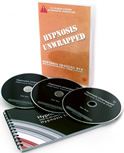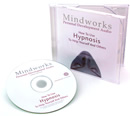
The basic hypnotic induction follows a classic form, is easy to perform and therefore great for beginners. Here are the elements of this type of induction:
a. The Truism
The statement at the start of the induction is the basicelement of a linguistic technique called pacing and leading. Pacing is the practice of meeting the subject's own experience. By commenting upon this, the hypnotist can useit to lead them into hypnotic trance.
At the start of this particular induction, the subject's eyes are elevated above the normal position. The eye muscles will inevitably tire because they are in an unnatural and strained position. The hypnotist anticipates this with the comment about the eyes becoming tired and the eyelids becoming heavy. This suggests to the subject that the hypnotist is actually producing the effect. Further commands will now be more readily accepted.
b. Rhythm
When hypnotising a subject, I would normally observe their rate of breathing and synchronise my speech and own breathing pattern with their breaths. This is done by watching the chest rise and fall or observing the nostrils. It is most effective to coincide suggestions of relaxation with the client's exhalations.
As the breathing rate decreases, so the hypnotist's speech rhythm decreases to match. This is a process of feedback since by slowing the speech rhythm, the hypnotist can also decrease the subject's rate of breathing. The hypnotist begins by speaking at normal speed and then gradually decreasing their rate of speech and breathing as the induction proceeds, until it is about 30% of normal.
c. The Hypnotic Voice
There are two kinds of vocal delivery used for hypnotising. The first is the monotone delivery, where there is very little inflexion to the voice. The conscious mind becomes bored by the hypnotist, while the unconscious mind accepts the hypnotic commands.
The second type is the undulating delivery, where the voice gently modulates and soothes the client into trance.
Your hypnosis voice will emanate from the unconscious and there is no 'secret' to this, it will evolve spontaneously. Just use a quiet but authoritative voice that suggests you are confident and know what you are doing. The words should flow smoothly and easily with no uneasy pauses. It would be best to memorise the induction so that you can speak easily and fluently. Eventually, you will discover your own style.
d. Occupying the Conscious Mind
The counting down from 300 is a simple but absorbing task for the conscious mind to perform. Because it is occupied doing this, it is less able to spot the hypnotic suggestions being offered. The critical faculty is being bypassed. This counting down technique can be enhanced by asking the subject to visualise each number as they count down, making each number a different colour. Any technique that occupies the conscious mind is useful in hypnosis because it assists the subject in becoming more inwardly focused and ignoring the stimuli around them.
e. Overloading the Conscious Mind
Despite being occupied with counting down, the conscious mind can still occasionally 'listen in' on the induction. In this induction, confusing combinations of words overload the conscious mind. When tied to suggestions that it is easier and easier to relax, this just seems the best way out. Relax, go with it, suspend conscious thought...
f. Embedded Commands
Commands such as 'relax' or 'your eyes are becoming tired' are preceded by a slight pause. This has the effect of subtly separating these commands from the rest of the text, although this is only perceived by the unconscious mind.
g. Using the Imagination
Remember, the imagination is rooted in the unconscious mind. By encouraging the subject to visualise, the hypnotist encourages the subject to abandon the analytical, critical conscious mind in favour of something more rewarding. The 'message' contained in the treasure chest is entirely personal to the subject rather than being imposed by the hypnotist.
h. The Release/Trance Termination
It is important that the release be performed correctly if the trance is to be of benefit to the subject. Don't worry about taking your time with this part because you cannot bring someone out of trance too slowly. Bringing them out too quickly is another matter entirely. For a subject in a very deep trance it's like being violently woken; disturbing and traumatic. Too quick a release will destroy the effect of the trance, so just take your time.
During the release, you should gradually increase the rhythm of speech and increase volume until you are back to normal levels, as you were when you began the induction.
From: Easy Mentalism by JP Jacquard
To learn some of the most controversial hypnosis techniques, check out the website below:
==> Covert Hypnosis Training Secrets
a. The Truism
The statement at the start of the induction is the basicelement of a linguistic technique called pacing and leading. Pacing is the practice of meeting the subject's own experience. By commenting upon this, the hypnotist can useit to lead them into hypnotic trance.
At the start of this particular induction, the subject's eyes are elevated above the normal position. The eye muscles will inevitably tire because they are in an unnatural and strained position. The hypnotist anticipates this with the comment about the eyes becoming tired and the eyelids becoming heavy. This suggests to the subject that the hypnotist is actually producing the effect. Further commands will now be more readily accepted.
b. Rhythm
When hypnotising a subject, I would normally observe their rate of breathing and synchronise my speech and own breathing pattern with their breaths. This is done by watching the chest rise and fall or observing the nostrils. It is most effective to coincide suggestions of relaxation with the client's exhalations.
As the breathing rate decreases, so the hypnotist's speech rhythm decreases to match. This is a process of feedback since by slowing the speech rhythm, the hypnotist can also decrease the subject's rate of breathing. The hypnotist begins by speaking at normal speed and then gradually decreasing their rate of speech and breathing as the induction proceeds, until it is about 30% of normal.
c. The Hypnotic Voice
There are two kinds of vocal delivery used for hypnotising. The first is the monotone delivery, where there is very little inflexion to the voice. The conscious mind becomes bored by the hypnotist, while the unconscious mind accepts the hypnotic commands.
The second type is the undulating delivery, where the voice gently modulates and soothes the client into trance.
Your hypnosis voice will emanate from the unconscious and there is no 'secret' to this, it will evolve spontaneously. Just use a quiet but authoritative voice that suggests you are confident and know what you are doing. The words should flow smoothly and easily with no uneasy pauses. It would be best to memorise the induction so that you can speak easily and fluently. Eventually, you will discover your own style.
d. Occupying the Conscious Mind
The counting down from 300 is a simple but absorbing task for the conscious mind to perform. Because it is occupied doing this, it is less able to spot the hypnotic suggestions being offered. The critical faculty is being bypassed. This counting down technique can be enhanced by asking the subject to visualise each number as they count down, making each number a different colour. Any technique that occupies the conscious mind is useful in hypnosis because it assists the subject in becoming more inwardly focused and ignoring the stimuli around them.
e. Overloading the Conscious Mind
Despite being occupied with counting down, the conscious mind can still occasionally 'listen in' on the induction. In this induction, confusing combinations of words overload the conscious mind. When tied to suggestions that it is easier and easier to relax, this just seems the best way out. Relax, go with it, suspend conscious thought...
f. Embedded Commands
Commands such as 'relax' or 'your eyes are becoming tired' are preceded by a slight pause. This has the effect of subtly separating these commands from the rest of the text, although this is only perceived by the unconscious mind.
g. Using the Imagination
Remember, the imagination is rooted in the unconscious mind. By encouraging the subject to visualise, the hypnotist encourages the subject to abandon the analytical, critical conscious mind in favour of something more rewarding. The 'message' contained in the treasure chest is entirely personal to the subject rather than being imposed by the hypnotist.
h. The Release/Trance Termination
It is important that the release be performed correctly if the trance is to be of benefit to the subject. Don't worry about taking your time with this part because you cannot bring someone out of trance too slowly. Bringing them out too quickly is another matter entirely. For a subject in a very deep trance it's like being violently woken; disturbing and traumatic. Too quick a release will destroy the effect of the trance, so just take your time.
During the release, you should gradually increase the rhythm of speech and increase volume until you are back to normal levels, as you were when you began the induction.
From: Easy Mentalism by JP Jacquard
To learn some of the most controversial hypnosis techniques, check out the website below:
==> Covert Hypnosis Training Secrets
 Thanks for visiting this blog. My name is Felix and I'm a part-time magician who is also interested in NLP and hypnosis. For more infos on hypnosis, please visit my website:
Thanks for visiting this blog. My name is Felix and I'm a part-time magician who is also interested in NLP and hypnosis. For more infos on hypnosis, please visit my website: 

No comments:
Post a Comment